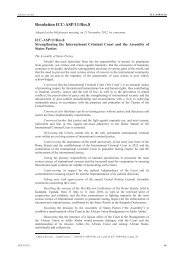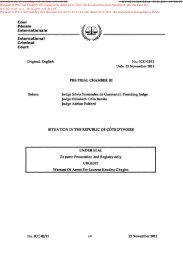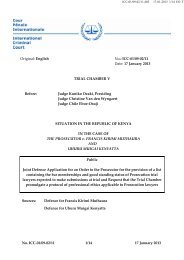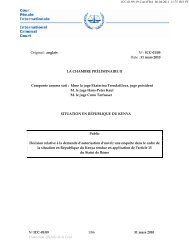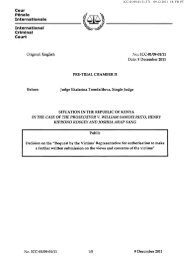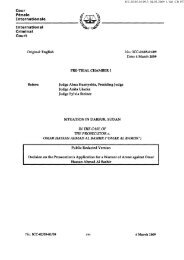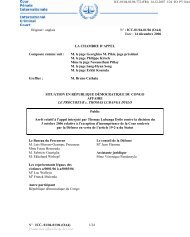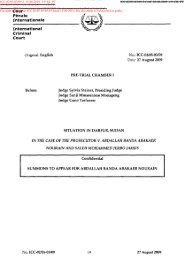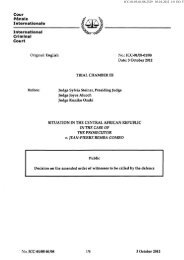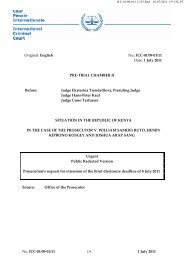Cour Pénale Internationale International Criminal Court
Cour Pénale Internationale International Criminal Court
Cour Pénale Internationale International Criminal Court
You also want an ePaper? Increase the reach of your titles
YUMPU automatically turns print PDFs into web optimized ePapers that Google loves.
ICC-01/04-01/06-1127 24-01-2008 6/14 EO Tit argued the Current Protocol is not suitable for adoption during the trialstage. 2013. In particular, the prosecution submitted that the E-<strong>Cour</strong>t Protocol should notbe a case analysis tool but rather a case-management tool as envisaged byRegulation 26 of the Regulations of the <strong>Cour</strong>t. 21It argued that theamendments made by the Pre Trial Chamber to the proposed E-<strong>Cour</strong>tProtocol submitted by the Registry and the parties, consisting of the additionof a range of case-specific data fields, were not in keeping with thatRegulation. The addition of such data-fields, it submitted, not only createdsignificant additional work for the parties with few or marginal benefits, but italso could mislead the parties and participants. 22Furthermore, in theprosecution's submission these additional data fields were of only limitedtemporal relevance and the Pre-Trial Chamber's partial reclassification of theconflict in Ituri from national to international rendered prior tagging in the"Element of alleged crime" field inaccurate. 2314. The defence argued that the Current E-<strong>Cour</strong>t Protocol was not inconsistentwith Regulation 26 of the Regulations of the <strong>Cour</strong>t and that the Protocol wasan important tool as currently configured, particularly in light of thesubstantial volume of material held by the Prosecutor that is not electronicallysearchable. 24Indeed, the defence submitted that its work, and the utility of theCurrent E-<strong>Cour</strong>t Protocol, would be enhanced by the addition of metadatafields describing the complete chain of custody of the evidence and the dateon which any source-imposed restrictions were lifted. 2520 Ibid., paragraphs 19-20.^ ICC-01/04-01/06-951, paragraph 41.22 Ibid., paragraph 42.23 ICC-01/04-01/06-852, paragraph 20.24 ICC-01/04-01/06-960, paragraphs 36-37.25 Ibid., paragraph 41.N°. ICC-01/04-01/06 6/14 24 January 2008
ICC-01/04-01/06-1127 24-01-2008 7/14 EO T15. The legal representatives of victim a/0105/06 and of victims a/0001/06 toa/0003/06 drew the Chamber's attention to the fact that victims'representatives were not consulted in the preparation and adoption of theCurrent E-<strong>Cour</strong>t Protocol and that they had had little subsequent opportunityto access E-<strong>Cour</strong>t compliant data. 26 Nevertheless, the legal representativeshighlighted the lack of victim-related information in the metadata fields, andthe representative of victim a/0105/06 submitted that a greater quantity of thisinformation should be incorporated in order to make the material disclosedpursuant to the Protocol of greater immediate utility to the victims itrepresents. 2716. At the Status Conference on 1 October 2007, it was submitted on behalf of theRegistrar that the E-<strong>Cour</strong>t Protocol was not intended to serve as a caseanalysistool. It was highlighted that pursuant to Regulation 52 of theRegulations of the Registry, the information provided under the Protocol isonly made available three days before its potential presentation at a courthearing. Thus, it is suggested this provision is not consistent with the Protocolbeing used for analysis of information by the parties. 28IV)Analysis and Conclusions17. The Chamber is grateful for the detailed work in this very technical areaundertaken by the highly qualified appointed expert 29 and it is persuaded bythe analysis and conclusions contained in the report.18. In its consideration of the report, its findings and the application andadaptation of the Current E-<strong>Cour</strong>t Protocol, the Chamber has been mindful26 ICC-01/04-01/06 961, paragraphs 33-34 and ICC-01/04-01/06-957, paragraph 28.27 1CC-OI/04-01/06-96I, paragraphs 36-37 and ICC-01/04-01/06-957, paragraph 29.28 1CC-01/04-01/06-T-52-ENG. page 102, lines 16-22.29 ICC-01/04-01/06-1024, paragraphs 4-17.N°. ICC-01/04-01/06 7/14 24 January 2008
ICC-01/04-01/06-1127 24-01-2008 8/14 EO Tnot only of the advanced stage currently reached in the proceedings and theimplications any significant changes would have on the timetable for trialpreparation but also of the resources available to the defence and the victims'representatives. It has also considered the alternative mechanisms by whichthe objectives of the Current E-<strong>Cour</strong>t Protocol could be achieved.19. The report supports the Chamber's view that e-court processes can greatlyenhance courtroom and trial efficiency and as such should be embraced by the<strong>Cour</strong>t. As the expert has set out, "in an e-court, courtroom participants canhave fast, well-organised access to the information that has been disclosedbeforehand (documents and statements), and to the information that is createdlive (the spoken word and the production and creation of exhibits)". 30 Thereare other potential uses such as case management, research, presentation athearings; exhibit management; transcript management; witness management;information to support judgments and procedural decisions; and courtadministration. 31The exponential increase in the volume of information,together with real problems that have emerged over informationmanagement, has meant that standardised protocols are necessary to governhow information can be prepared and presented. 32 Important experience 33 hasdemonstrated that a protocol which is drawn to capture purely objectiveinformation 34about documents or records related to each case is the mostuseful approach: this enables the exchange, search, retrieval and presentationof information in the easiest, as well as most precise and consistent way, onmultiple occasions. 35 Critically, the experience of those courts is that theseobjectives cannot be met by the addition of subjective information: indeed, the30 ICC-01/04-01/06-1024, paragraph 28.31 Ibid, paragraph 30.32 Ibid, paragraphs 33 and 34.33 This experience derives from Australia (particularly in the Supreme <strong>Cour</strong>ts of Victoria and New South Wales),which is being considered and adopted by a number of national and international courts. Ibid, paragraph 43.34 Namely, information that is apparent from the face of the document (the date, author, recipient etc), ICC-01 /04-01 /06-1024, paragraph 46.35 Ibid, paragraphs 35 and 36.N°. ICC-01/04-01/06 8/14 24 January 2008
ICC-01/04-01/06-1127 24-01-2008 9/14 EO Tinclusion of subjective fields works actively against them. 36The expertdescribed this issue thus: "Although subjective fields are important tools forcase preparation and analysis, they [...] do not generally form part ofprotocols used today." 37The author emphasised that subjective fields cannotbe handled in the same way as objective ones. In particular:a) Subjective information in a record takes longer to locate and analyse, and a subjectivefield often contains more information than an objective field would hold.b) Searching material based on subjective fields or full text searches yields results thatare relative, not absolute. The integrity of subjective searches depends on the qualityof the subjective information captured, the ability to construct an effective search, andthe sheer subjective differences between one person's work and another.c) The relative nature of subjective searching gives rise to the risk of misapprehensionthat any results are in some way a comprehensive list of records relevant to the issuessearched for. 3820. The expert recognised the importance of capturing and utilising subjectiveinformation as a part of case analysis generally. However, the unequivocalview expressed was that this is best undertaken separately by each party,given that the appropriate focus in capturing any subjective information willdepend entirely on the role each party has to play in the case. The difference inthe way the parties are likely to structure their cases will mean that theexchange of subjective information will often serve little purpose, since theirindividual interests will lead to disparate approaches to information. 39 Indeed,the expert observes that subjective fields of the kind proposed have neverbeen included in a protocol. 40 To the extent to which the (subjective) materialis protocol-compliant, it can easily be exported into a stand-alone case analysissystem. 4121. In consequence, the Chamber agrees with the expert that the metadata fieldsshould not extend beyond those identified as "objective" in paragraph 52 of36 Ibid, paragraph 36.37 Ibid, paragraph 36.38 Ibid, paragraph 63.39 Ibid, paragraph 6440 Ibid, paragraph 82.41 Ibid, paragraph 67.N°. ICC-01/04-01/06 9/14 24 January 2008
ICC-01/04-01/06-1127 24-01-2008 10/14 EO Tthe report, since adding subjective fields would not best facilitate the <strong>Cour</strong>t'swork and would reduce the universal value of the Protocol across all cases.22. In order to maximise the utility and the coherency of the application of the E-<strong>Cour</strong>t Protocol, this decision should be applied to all exchanged materials,regardless of the particular stage in the proceedings at which they weredisclosed. The objective metadata fields identified by the expert 42 should beincluded unless the prosecution within 7 days of this Decision files reasons forthe Chamber's consideration as to why this is not reasonably achievablebefore trial. Moreover, the Chamber endorses the view of the expert that theProtocol should cover "all case information filed with the Registry orexchanged between parties/participants". 43 This, by definition, extendsequally to the incriminatory and potentially exculpatory material exchangedbetween the parties.23. An exception to this approach applies to the semi or completely illegiblematerials, given that there are 15,000 documents that are either written byhand or otherwise cannot be searched electronically. 44 The principle reason forpermitting this exception is the imminence of the trial and the difficulties atthis point in time for the prosecution of revisiting each of the relevantdocuments to apply the relevant objective coding or typing the record in fullfor electronic searching. 45 The Chamber stresses this exception is made purelybecause of the stage in the case that has been reached.24. There is no reason to distinguish between the parties and the participants inthe approach identified above. The prosecution, the defence and the victims'representatives will all be able, if they wish, to improve individually on the42 Ibid, paragraph 52.43 ICC-01/04-01/06-1062, paragraph 9.44 ICC-01/04-01/06-1024, paragraph 83.45 Ibid, paragraphs 85 and 86.N°. ICC-01/04-01/06 10/14 24 January 2008
ICC-01/04-01/06-1127 24-01-2008 11/14 EO T(low level) case analysis tool that the protocol will provide by using their owndiscrete case analysis systems. 4625. Accordingly, the Chamber directs that the objective fields, including those"proposed victim information" fields set out at paragraph 52 of the reportwhich are described as 'objective/ should be added to the Current E-<strong>Cour</strong>tProtocol.26. Turning to the additional metadata fields on which the expert was unable toprovide an opinion, the Chamber is of the view that the parties andparticipants are entitled to receive details on the "Full Chain of Custody ofMaterial Evidence" 47 and on the "Date Source Restriction Lifted" 48 but that thisinformation need not necessarily be provided via the E-<strong>Cour</strong>t metadata. If theprosecution has been routinely providing this information in a clearlyidentifiable alternative way, it may continue to do so. Accordingly, theChamber directs that this information should be provided by whatever meansis most convenient to the providing party. On the other hand, the Chamberdoes not consider that the addition of the "Person/Witness from whom theDocument Originated" 49is an onerous requirement and directs that thisshould form part of the E-<strong>Cour</strong>t Protocol, unless the prosecution within 7 daysof this Decision files reasons for the Chamber's consideration as to why this isnot reasonably achievable before trial.27. The Chamber notes the practice of grouping three victims under one victimcode, highlighted at paragraph 109 of the report, and directs the parties infuture to make the change suggested in that paragraph, i.e. to allocate aunique number to each victim participant.46 Ibid, paragraph 80.47 Ibid, paragraph 52 a.xi.48 Ibid, paragraph 52 a.xii.49 Ibid, paragraph 52 b.vii.N°. ICC-01/04-01/06 11/14 24 January 2008
ICC-01/04-01/06-1127 24-01-2008 12/14 EO T28. The Chamber also notes the question raised by the expert in paragraph 110 ofthe report in relation to the resources available to the defence in order tomaximise its use of the Current E-<strong>Cour</strong>t Protocol. The Registry consequentlyshould provide facilities and assistance for training of the defence team andlegal representatives of victims participating in the proceedings in the use andapplication of the Current E-<strong>Cour</strong>t Protocol, if they feel that such assistancewould be of benefit to their work.29. While the Chamber's directions are limited to the present trial, it agrees withthe reasoning behind the expert's view on the standardisation of an E-<strong>Cour</strong>tprotocol across the proceedings of the <strong>Cour</strong>t as a whole. The Chamberobserves that the prosecution has not viewed the Pre-Trial Chamber's versionof the E-<strong>Cour</strong>t Protocol as binding on it subsequent to the Confirmation ofCharges. This does not appear to be consistent with the principles whichunderpin the Protocol. A pre-determined and consistent approach to theformat according to which disclosure would occur would result in savings in<strong>Cour</strong>t time. In addition, the Chamber anticipates that there would besignificant efficiencies in terms of the overlap in documents collected in thecontext of a single situation and which may be suitable for disclosure in morethan one trial. Since those documents would, in the main, require processingfor E-court compliance on only one occasion, particularly when suchcompliance is limited to the objective fields which have been the focus of thepresent Decision, the benefits, inter alia, in terms of resources, may beimportant. Accordingly, the Chamber encourages the Office of the Prosecutorto examine the wider applicability of the E-<strong>Cour</strong>t Protocol and the potentialfor its consistent and universal implementation in all situations and casesunless and until another Chamber deems it necessary to depart from it. 5050 ICC-01/04-01/06-1024, paragraphs 100-103.N°. ICC-01/04-01/06 12/14 24 January 2008
ICC-01/04-01/06-1127 24-01-2008 13/14 EO TV) Orders of the Trial Chamber30. For these reasons, the Trial Chamber hereby orders the following:a) All documents disclosed by the parties and participants shall be provided in aProtocol-compliant format, with the required metadata fields beingcompleted. The objective fields including the "proposed victim information"fields identified at paragraph 52 of the report, as well as the "Person/Witnessfrom whom the Document Originated" field, shall be included in the E-<strong>Cour</strong>tProtocol in relation to all materials exchanged, save for semi or completelyillegible material, unless the prosecution files reasons for the Chamber'sconsideration as to why this is not reasonably achievable before trial within 7days of this Decision.b) Information on the "Full Chain of Custody of Material Evidence" and on the"Date Source Restriction Lifted" shall be communicated by whatever means ismost convenient to the providing party.c) In future, a unique number ("Participant Codes" field) shall be allocated toeach victim participant.d) The Registry should provide facilities and assistance for training of thedefence team and legal representatives of victims participating in theproceedings in the use and application of the E-<strong>Cour</strong>t Protocol, if they feel thatsuch assistance would be of benefit to their work.e) The Office of the Prosecutor is encouraged to examine the wider applicabilityof the E-<strong>Cour</strong>t Protocol and the potential for its implementation in allsituations and cases.N°. ICC-01/04-01/06 13/u 24 January 2008
ICC-01/04-01/06-1127 24-01-2008 14/14 EO TJudge René Blattmann was consulted but is unavailable to sign the Decision as he isaway from the seat of the <strong>Cour</strong>t on the day of signature.Done in both English and French, the English version being authoritative.Judge Adrian FulfordJudge Elizabeth Odio BenitoJudge René BlattmannDated this 24 January 2008At The Hague, The NetherlandsN°. ICC-01/04-01/06 14/14 24 January 2008



